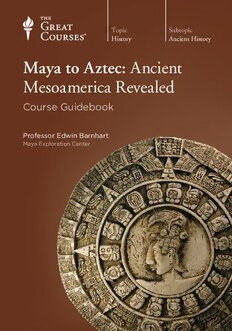
Maya to Aztec: Ancient Mesoamerica Revealed PDF
Preview Maya to Aztec: Ancient Mesoamerica Revealed
Topic Subtopic History Ancient History Maya to Aztec: Ancient Mesoamerica Revealed Course Guidebook Professor Edwin Barnhart Maya Exploration Center PUBLISHED BY: THE GREAT COURSES Corporate Headquarters 4840 Westfields Boulevard, Suite 500 Chantilly, Virginia 20151-2299 Phone: 1-800-832-2412 Fax: 703-378-3819 www.thegreatcourses.com Copyright © The Teaching Company, 2015 Printed in the United States of America This book is in copyright. All rights reserved. Without limiting the rights under copyright reserved above, no part of this publication may be reproduced, stored in or introduced into a retrieval system, or transmitted, in any form, or by any means (electronic, mechanical, photocopying, recording, or otherwise), without the prior written permission of The Teaching Company. Edwin Barnhart, Ph.D. Director Maya Exploration Center P rofessor Edwin Barnhart is Director of the Maya Exploration Center. He received his Ph.D. in Anthropology with a focus on Archaeology from The University of Texas at Austin in 2001; his dissertation was entitled The Palenque Mapping Project: Settlement Patterns and Urbanism in an Ancient Maya City. Professor Barnhart has more than 20 years of experience as an archaeologist, explorer, and instructor in North, Central, and South America and has published more than a dozen papers and given presentations at eight international conferences. Professor Barnhart’s involvement in Maya studies began in 1990 as an archaeological intern in the ruins of Copan, Honduras. In January of 1996, he was invited to return to Copan and help a team from the University of Pennsylvania excavate the early acropolis and the tomb of the city’s lineage founder. From 1992 to 1995, Professor Barnhart studied New World art, iconography, and epigraphy (hieroglyphic translation) under the late Dr. Linda Schele at The University of Texas at Austin. During that time, he intensively studied the Andean culture, writing a number of papers about Moche shamanism as seen through art and iconography. In 1994, Professor Barnhart began working as a surveyor and University (cid:82)(cid:73)(cid:3)(cid:55)(cid:72)(cid:91)(cid:68)(cid:86)(cid:3)(cid:191)(cid:72)(cid:79)(cid:71)(cid:3)(cid:86)(cid:70)(cid:75)(cid:82)(cid:82)(cid:79)(cid:3)(cid:76)(cid:81)(cid:86)(cid:87)(cid:85)(cid:88)(cid:70)(cid:87)(cid:82)(cid:85)(cid:3)(cid:76)(cid:81)(cid:3)(cid:87)(cid:75)(cid:72)(cid:3)(cid:77)(cid:88)(cid:81)(cid:74)(cid:79)(cid:72)(cid:86)(cid:3)(cid:82)(cid:73)(cid:3)(cid:81)(cid:82)(cid:85)(cid:87)(cid:75)(cid:90)(cid:72)(cid:86)(cid:87)(cid:72)(cid:85)(cid:81)(cid:3)(cid:37)(cid:72)(cid:79)(cid:76)(cid:93)(cid:72)(cid:17)(cid:3)(cid:36)(cid:73)(cid:87)(cid:72)(cid:85)(cid:3) (cid:191)(cid:81)(cid:71)(cid:76)(cid:81)(cid:74)(cid:3)(cid:81)(cid:88)(cid:80)(cid:72)(cid:85)(cid:82)(cid:88)(cid:86)(cid:3)(cid:86)(cid:80)(cid:68)(cid:79)(cid:79)(cid:3)(cid:89)(cid:76)(cid:79)(cid:79)(cid:68)(cid:74)(cid:72)(cid:86)(cid:15)(cid:3)(cid:75)(cid:72)(cid:3)(cid:71)(cid:76)(cid:86)(cid:70)(cid:82)(cid:89)(cid:72)(cid:85)(cid:72)(cid:71)(cid:3)(cid:87)(cid:75)(cid:72)(cid:3)(cid:68)(cid:81)(cid:70)(cid:76)(cid:72)(cid:81)(cid:87)(cid:3)(cid:70)(cid:76)(cid:87)(cid:92)(cid:3)(cid:82)(cid:73)(cid:3)(cid:48)(cid:68)(cid:68)(cid:91)(cid:3) (cid:49)(cid:68)(cid:3)(cid:11)(cid:179)(cid:54)(cid:83)(cid:76)(cid:71)(cid:72)(cid:85)(cid:16)(cid:48)(cid:82)(cid:81)(cid:78)(cid:72)(cid:92)(cid:3)(cid:43)(cid:82)(cid:88)(cid:86)(cid:72)(cid:180)(cid:12)(cid:15)(cid:3)(cid:68)(cid:3)(cid:80)(cid:68)(cid:77)(cid:82)(cid:85)(cid:3)(cid:70)(cid:72)(cid:81)(cid:87)(cid:72)(cid:85)(cid:3)(cid:82)(cid:73)(cid:3)(cid:87)(cid:75)(cid:72)(cid:3)(cid:38)(cid:79)(cid:68)(cid:86)(cid:86)(cid:76)(cid:70)(cid:3)(cid:48)(cid:68)(cid:92)(cid:68)(cid:3)(cid:83)(cid:72)(cid:85)(cid:76)(cid:82)(cid:71)(cid:17)(cid:3) Professor Barnhart mapped more than 600 structures at Maax Na between 1995 and 1997 before moving his research focus to Chiapas, Mexico. He received his master’s degree in Latin American Studies in May of 1996 and began teaching anthropology classes at what is now Texas State University the following September. He taught archaeology and anthropology classes there until 1998, when he was invited by the Mexican government to direct i (cid:87)(cid:75)(cid:72)(cid:3)(cid:51)(cid:68)(cid:79)(cid:72)(cid:81)(cid:84)(cid:88)(cid:72)(cid:3)(cid:48)(cid:68)(cid:83)(cid:83)(cid:76)(cid:81)(cid:74)(cid:3)(cid:51)(cid:85)(cid:82)(cid:77)(cid:72)(cid:70)(cid:87)(cid:15)(cid:3)(cid:68)(cid:3)(cid:87)(cid:75)(cid:85)(cid:72)(cid:72)(cid:16)(cid:92)(cid:72)(cid:68)(cid:85)(cid:3)(cid:72)(cid:73)(cid:73)(cid:82)(cid:85)(cid:87)(cid:3)(cid:87)(cid:82)(cid:3)(cid:86)(cid:88)(cid:85)(cid:89)(cid:72)(cid:92)(cid:3)(cid:68)(cid:81)(cid:71)(cid:3)(cid:80)(cid:68)(cid:83)(cid:3)(cid:87)(cid:75)(cid:72)(cid:3) unknown sections of Palenque’s ruins. More than 1,100 new structures were documented, bringing the site total to almost 1,500. The resultant map has been celebrated as one of the most detailed and accurate ever made of a Maya ruin. In 2003, Professor Barnhart became Director of the Maya Exploration Center, an institution dedicated to the study of ancient Maya civilization. He (cid:75)(cid:68)(cid:86)(cid:3)(cid:79)(cid:72)(cid:71)(cid:3)(cid:71)(cid:82)(cid:93)(cid:72)(cid:81)(cid:86)(cid:3)(cid:82)(cid:73)(cid:3)(cid:86)(cid:87)(cid:88)(cid:71)(cid:72)(cid:81)(cid:87)(cid:3)(cid:74)(cid:85)(cid:82)(cid:88)(cid:83)(cid:86)(cid:3)(cid:82)(cid:81)(cid:3)(cid:77)(cid:82)(cid:88)(cid:85)(cid:81)(cid:72)(cid:92)(cid:86)(cid:3)(cid:87)(cid:75)(cid:85)(cid:82)(cid:88)(cid:74)(cid:75)(cid:3)(cid:48)(cid:72)(cid:91)(cid:76)(cid:70)(cid:82)(cid:15)(cid:3)(cid:42)(cid:88)(cid:68)(cid:87)(cid:72)(cid:80)(cid:68)(cid:79)(cid:68)(cid:15)(cid:3) Peru, and Bolivia. Over the last 10 years, Professor Barnhart has appeared multiple times on the History Channel; the Discovery Channel; and NHK, a Japanese public television network. In addition, he is a Fellow of the Explorers Club and teaches University of Texas travel courses for college professors on ancient Andean and Mesoamerican astronomy, mathematics, and culture. For The (cid:42)(cid:85)(cid:72)(cid:68)(cid:87)(cid:3)(cid:38)(cid:82)(cid:88)(cid:85)(cid:86)(cid:72)(cid:86)(cid:15)(cid:3)(cid:75)(cid:72)(cid:3)(cid:75)(cid:68)(cid:86)(cid:3)(cid:68)(cid:79)(cid:86)(cid:82)(cid:3)(cid:87)(cid:68)(cid:88)(cid:74)(cid:75)(cid:87)(cid:3)Lost Worlds of South America. (cid:374) ii Table of Contents INTRODUCTION Professor Biography ............................................................................i Course Scope .....................................................................................1 LECTURE GUIDES LECTURE 1 The Maya, Aztecs, and Mesoamerica ................................................5 LECTURE 2 Olmec Civilization Emerges..............................................................12 LECTURE 3 Olmec Art as the Mother Culture ......................................................18 LECTURE 4 Olmec Contemporaries.....................................................................25 LECTURE 5 Mesoamerican Plants, Cuisine, and Medicine..................................32 LECTURE 6 Early Highland Maya—Izapa to Kaminaljuyu ...................................39 LECTURE 7 Preclassic Maya Lowlands—El Mirador ...........................................46 LECTURE 8 The Popol Vuh—Creation and Hero Twins .......................................52 LECTURE 9 The Great City of Teotihuacan ..........................................................58 LECTURE 10 How the Maya Mastered Mathematics .............................................65 iii Table of Contents LECTURE 11 The World’s Most Elaborate Calendar ..............................................71 LECTURE 12 Tikal—Aspiring Capital of the Maya World .......................................78 LECTURE 13 Maya Hieroglyphs—Breaking the Code ...........................................85 LECTURE 14 Maya Astronomy and Building Orientations......................................92 LECTURE 15 The Dresden Codex .........................................................................99 LECTURE 16 Palenque—Jewel in the West .........................................................105 LECTURE 17 Sacred Geometry in Art and Architecture .......................................112 LECTURE 18 Illuminating Works of Maya Art .......................................................118 LECTURE 19 Copan—Jungle Dynasty of the East...............................................124 LECTURE 20 Calakmul—The Mighty Snake Kingdom .........................................131 LECTURE 21 The Mesoamerican Ball Game .......................................................137 LECTURE 22 Enigmatic West Mexico and Shaft Tombs ......................................144 LECTURE 23 Classic Maya Collapse—Cities Abandoned! ..................................151 iv Table of Contents LECTURE 24 New Cities of the Terminal Classic—Uxmal ...................................157 LECTURE 25 Monte Alban and Zapotec Rule over Oaxaca .................................164 LECTURE 26 The Mixtec Rise—Gold and Epic Stories .......................................171 LECTURE 27 The Great Pyramid of Cholula and El Tajin ....................................178 LECTURE 28 Cacaxtla Murals and Xochicalco ....................................................185 LECTURE 29 The Toltecs—Role Models or Myth? ...............................................192 LECTURE 30 Chichen Itza—Maya Capital of the Yucatan ...................................199 LECTURE 31 League of Mayapan—Maya New World Order ...............................206 LECTURE 32 Mesoamerican Religion ..................................................................213 LECTURE 33 Aztec Origins—Arrival and Rise of the Mexica ...............................220 LECTURE 34 The Aztec Capital of Tenochtitlan ...................................................226 LECTURE 35 Life in the Aztec World ....................................................................233 LECTURE 36 How the Aztecs Expanded Their Empire ........................................240 v Table of Contents LECTURE 37 Independent Tarascans—Desert Warriors......................................248 LECTURE 38 Paquime—Northernmost Mesoamerican City? ..............................255 LECTURE 39 Illuminating Works of Aztec Art .......................................................263 LECTURE 40 Tulum—Aztecs at the Ancient Maya Port City ................................269 LECTURE 41 First Contact with Europe in Mesoamerica .....................................276 LECTURE 42 The Siege of Tenochtitlan ...............................................................283 LECTURE 43 Conquest of the Maya and Landa’s Legacy ...................................290 LECTURE 44 Fall of the Last Maya Kingdom—The Itza ......................................297 LECTURE 45 The Caste Wars of Yucatan ............................................................304 LECTURE 46 Echoes of the Past in Mexico .........................................................311 LECTURE 47 Maya Survival and Revival .............................................................318 LECTURE 48 Frontiers of Mesoamerican Archaeology ........................................325 vi Table of Contents SUPPLEMENTAL MATERIAL Bibliography ....................................................................................332 vii viii
